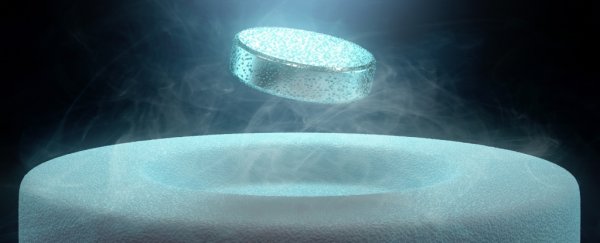Scientists in Germany have hit a new superconductivity milestone - achieving a resistance-free electrical current at the highest temperature yet: just 250 Kelvin, or -23 degrees Celsius (-9.4 degrees Fahrenheit).
The work was led by Mikhail Eremets, a physicist at the Max Planck Institute for Chemistry, who set the previous high temperature record for superconductivity in 2014, at 203 Kelvin (-70 degrees Celsius).
Superconductivity, first discovered in 1911, is a curious phenomenon. Usually, the flow of an electrical current encounters some degree of resistance - a bit like how air resistance pushes back on a moving object, for example.
The higher the conductivity of a material, the less electrical resistance it has, and the current can flow more freely.
But at low temperatures in some materials, something strange happens. Resistance lowers to zero, and the current flows unimpeded. When accompanied by something called the Meissner effect - the expulsion of the material's magnetic fields as it transitions below that critical temperature - this is called superconductivity.
So-called room-temperature superconductivity, above 0 degrees Celsius, is something of a white whale for scientists. If it could be achieved, it would revolutionise electrical efficiency, vastly improving power grids, high-speed data transfer, and electrical motors, to name a few potential applications.
So it's something that many laboratories around the world have been working on, with new claims of high-temperature superconductivity rearing from time to time that then fail reproducibility tests.
Eremets and his team achieved the previous high-temperature superconductivity record using hydrogen sulfide - yep, the compound that makes rotten eggs and human flatulence stinky - under 150 gigapascals of pressure (Earth's core is between 330 and 360 gigapascals).
Scientists who rushed to understand hydrogen sulfide superconductivity believe that this result is possible because hydrogen sulfide is so light a material that it can vibrate at high speeds, which means higher temperatures - but the pressure is needed to keep it from vibrating itself apart.
This new research used a different material, called lanthanum hydride, under about 170 gigapascals of pressure. Earlier this year, the team reported they had achieved superconductivity using this material at 215 Kelvin (-58.15 C°, -72 F°) - and now, just a few months later, they have improved on that result.
The new temperature is nearly half the average winter temperature at the North Pole.
"This leap, by 50 Kelvin, from the previous critical temperature record of 203 Kelvin," the researchers wrote in their paper, "indicates the real possibility of achieving room-temperature superconductivity (that is at 273 Kelvin) in the near future at high pressures, and the perspective of conventional superconductivity at ambient pressure."
There are three tests, reports MIT Technology Review, that are considered the gold standard for superconductivity, and the team has only achieved two: the drop in resistance below a critical temperature threshold, and replacing elements in the material with heavier isotopes to observe a corresponding drop in superconductivity temperature.
The third is the Meissner effect, which is the name given to one of the signatures of superconductivity. As the material passes below the critical temperature and transitions into superconductivity, it ejects its magnetic field.
The team has yet to observe this phenomenon because their sample is so small - well below the detection capabilities of their magnetometer. However, the transition into superconductivity has an effect on the external magnetic field, too. It's not a direct detection, but the team was able to observe this effect.
It's not the Meissner effect, but it does look promising. And you can bet that physicists with the ability to do so will be falling over each other to verify and attempt to replicate the team's result.
The paper has been published in Nature, and a pre-print is available on arXiv.
A previous version of this article covering the pre-print version of the research was published in December 2018.
